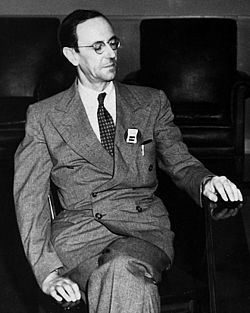Sir James Chadwick CH FRS, (20 October 1891 – 24 July 1974) was an English physicist and Nobel Prize winner who is best known for discovering the neutron.[1]
Sir James Chadwick | |
|---|---|
 Sir James Chadwick c. 1945 | |
| Born | James Chadwick October 20, 1891 |
| Died | 24 July 1974 (aged 82) |
| Nationality | British |
| Citizenship | United Kingdom |
| Education | University of Manchester University of Cambridge |
| Known for | Discovery of the neutron |
| Awards | Nobel Prize in Physics, 1935Nobel Prize in Physics (1935) Franklin Medal (1951) |
| Scientific career | |
| Fields | Physics |
| Institutions | Technical University of Berlin University of Liverpool Gonville and Caius College University of Cambridge Manhattan Project |
| Academic advisors | Ernest Rutherford Hans Geiger |
| Doctoral students | Maurice Goldhaber Ernest C. Pollard Charles Drummond Ellis |
Biography
changeJames Chadwick was born in Bollington, Cheshire, England. He went to Manchester High School, and studied at the Universities of Manchester and Cambridge. In 1913, Chadwick went to Berlin in Germany to work with the scientist Hans Geiger. He also worked with Ernest Rutherford. He was still in Germany when World War I broke out and he was interned in Ruhleben P.O.W. Camp just outside Berlin. In the camp, which had more than 5,000 detainees (prisoners of war) had been a horse racetrack. There were stables, each with 27 horse boxes. The detainees lived in these boxes. The detainees were allowed to do things to keep themselves busy. Chadwick worked with a young scientist called Charles Ellis. Together they set up a laboratory in the stables where they worked on the ionisation of phosphorus and also on the photochemical reaction of carbon monoxide and chlorine.
Career
changeResearch at Cambridge
changeAfter the war, Chadwick returned to Cambridge where he worked with Ernest Rutherford, studying the emission of gamma rays from radioactive materials. They also studied the transmutation of elements by bombarding them with alpha particles, and investigated the nature of the atomic nucleus.
In 1932 Chadwick made a very important discovery: he discovered the particle in the nucleus of an atom that became known as the neutron because it has no electric charge. In contrast with the helium nuclei (alpha particles) which are positively charged, and therefore repelled by the strong electrical forces in the nuclei of heavy atoms, this new tool in atomic disintegration need not overcome any electric barrier and is capable of penetrating and splitting the nuclei of even the heaviest elements. In this way, Chadwick prepared the way towards the fission of uranium 235 and towards the creation of the atomic bomb. For this important discovery he was awarded the Hughes Medal of the Royal Society in 1932, and later the Nobel Prize for Physics in 1935. He was also nicknamed "Jimmy Neutron" because of his discovery of the neutron.
Liverpool
changeChadwick became professor of physics at Liverpool University in 1935. He worked on the possibility of an atomic bomb. Later he realized that the nuclear bomb really was going to be made. He found it very frightening that the science he had been working on could lead to such a terrible weapon. He started to take sleeping pills.
He joined the Manhattan Project in the United States, which developed the atomic bombs dropped on Hiroshima and Nagasaki. Chadwick was knighted in 1945.
Return to Cambridge
changeAfter the war, Chadwick moved to Cambridge University as master of Gonville and Caius College.
He died in Cambridge on 24 July 1974.
Sources
change- ↑ Brown, Andrew (1997). The neutron and the bomb: a biography of Sir James Chadwick. Oxford [Oxfordshire]: Oxford University Press. ISBN 0-19-853992-4.
Other websites
change- Annotated bibliography for James Chadwick from the Alsos Digital Library for Nuclear Issues Archived 2019-02-17 at the Wayback Machine
- Nobel prize Website entry
- The Papers of Sir James Chadwick Archived 2014-05-27 at Archive.today are held at the Churchill Archives Centre in Cambridge and are accessible to the public.